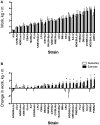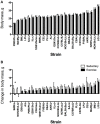Differences in Exercise Capacity and Responses to Training in 24 Inbred Mouse Strains
- PMID: 29249981
- PMCID: PMC5714923
- DOI: 10.3389/fphys.2017.00974
Differences in Exercise Capacity and Responses to Training in 24 Inbred Mouse Strains
Abstract
Changes in cardiorespiratory fitness in response to a standardized exercise training protocol differ substantially between individuals. Results from cross-sectional, twin, and family studies indicate genetics contribute to individual differences in both baseline exercise capacity and the response to training. Exercise capacity and responses to training also vary between inbred strains of mice. However, such studies have utilized a limited number of inbred strains. Therefore, the aim of this study was to characterize exercise-training responses in a larger number of genetically diverse strains of inbred mice and estimate the contribution of genetic background to exercise training responses. Eight-week old male mice from 24 inbred strains (n = 4-10/strain) performed a graded exercise test before and after 4 weeks of exercise training. Before training, exercise capacity was significantly different between strains when expressed as time (range = 21-42 min) and work performed (range = 0.42-3.89 kg·m). The responses to training also were significantly different between strains, ranging from a decrease of 2.2 min in NON/ShiLtJ mice to an increase of 8.7 min in SWR/J mice. Changes in work also varied considerably between the lowest (-0.24 kg·m in NON/ShiLtJ) and highest (+2.30 kg·m in FVB/NJ) performing strains. Heart and skeletal muscle masses also varied significantly between strains. Two broad sense heritability estimates were calculated for each measure of exercise capacity and for responses to training. For change in run time, the intraclass correlation between mice within the same inbred strain (rI) was 0.58 and the coefficient of genetic determination (g2) was 0.41. Heritability estimates were similar for the change in work: rI = 0.54 and g2 = 0.37. In conclusion, these results indicate genetic background significantly influences responses to exercise training.
Keywords: exercise training; heart; heritability; inbred strains; muscle; treadmill running.
Figures





References
-
- Al-Jarrah M., Pothakos K., Novikova L., Smirnova I. V., Kurz M. J., Stehno-Bittel L., et al. . (2007). Endurance exercise promotes cardiorespiratory rehabilitation without neurorestoration in the chronic mouse model of parkinsonism with severe neurodegeneration. Neuroscience 149, 28–37. 10.1016/j.neuroscience.2007.07.038 - DOI - PMC - PubMed
-
- Barbato J. C., Koch L. G., Darvish A., Cicila G. T., Metting P. J., Britton S. L. (1998). Spectrum of aerobic endurance running performance in eleven inbred strains of rats. J. Appl. Physiol. 85, 530–536. - PubMed
Grants and funding
LinkOut - more resources
Full Text Sources
Other Literature Sources
Molecular Biology Databases

